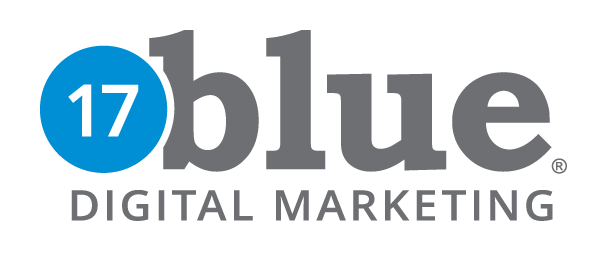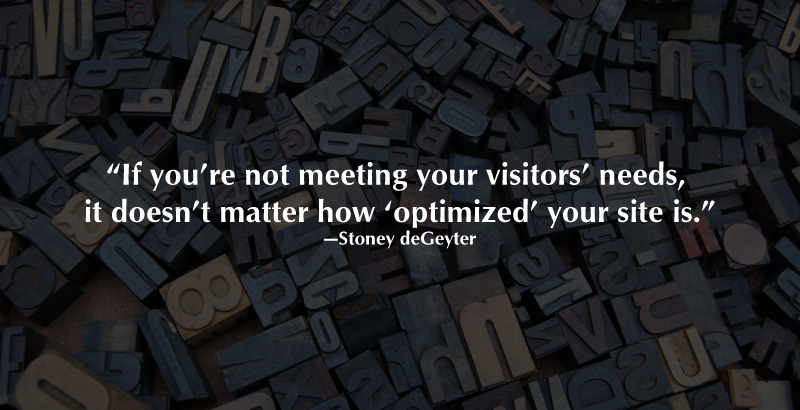This article is part of a series on sections of the “SEO pie.” Yes, it literally started with a pie chart.
It’s More Natural than You Might Think.
While you’ve been busy working on your business, Search Optimization has changed a lot in the past few years. The digital landscape has become increasingly competitive. There are currently over 1.8 billion active websites globally. Over 5 million blogs are written each day. That’s a lot of data to assimilate, index and serve up in a relevant format for searchers. Given the sheer volume of data online, perhaps the most notable shift in SEO is a conceptual shift from quantity to quality. Rather than create content for a very wide audience, it’s become very important to speak with high relevance to a specific, narrow audience. And rather than create many pieces of content, it’s become more important to create high-quality content that specific users want to receive and share with others.
When discussing content optimization in this digitally competitive climate, we must look at more than tips or techniques for where to place keywords. Now content creators must realize they aren’t producing content for any user, but for a very specific user with very specific motivations and needs. By dialing in content creation to your audience with precision, you are poised for much greater success when applying other optimization tactics or techniques. Now, you’re focused on creating specific high-quality content for a well-understood audience. If that’s your goal, much of your content optimization will happen naturally. Don’t believe me? Here’s an example. In writing this introduction about approaching SEO from the right mindset, we have already used the following search terms in two paragraphs naturally – without manually inserting them just for SEO benefit:
-
- Search Optimization
- data
- searchers
- SEO (3)
- create content
- high relevance
- pieces of content
- high-quality content (2)
- content optimization (2)
- keywords
- audience (4)
- (optimization) tips/tactics/techniques (4)
By offering quality information to help your readers or viewers get what they’re looking for, you are going to naturally optimize content in your area of expertise.
Once you’re focused on delivering great information that helps people solve a problem or make a decision… you’re ready to employ some techniques to ensure you’re maximizing your effectiveness.
Content Optimization Techniques to Remember
-
- Set Goals for Quality Traffic over just Traffic Volume. It may seem simplistic, but 10% of 1,000 is the same as 1% of 10,000. There is a difference when higher volume just produces larger bounce rates and lower engagement. Optimizing and advertising (paying) for larger volumes of visitors that don’t love your content drives down relevance metrics and social proof metrics. People are not cattle. They’re looking for something specific. You want to offer up your unique, specialized content to the audience that will love it. Even if it’s a smaller audience.
- Give Time for Creative Ideation in Titles. Don’t skip this one. Amazing content can go unnoticed, unopened and unread due to a lack creativity. Be creative in coming up with content ideas and titles. There are points for making a title reflect the content, but if the title is too flat the people who are looking for engagement and resonance won’t ever see it. Spend time in a group think-tank. Brainstorm strategies for content ideas and get input from your audience. Make sure your team’s “witty genius” is part of brainstorming themes, titles and section headings. Having a little fun here can make sure your work on content is seen.
- Optimize Titles and Subtitles. Be sure your titles, subtitles and section headings contain your primary keyword phrase for the piece of content. In this article, the words “Content Optimization” and “SEO” both appear in the title and this sectionheading.
- Create Original Content that’s Focused on Quality. Stats, quotes and other sources can inform your efforts, but your content should be written in your own, original words. Keep your content original and do your best to add insight that will be meaningful to your audience.
- Deliver what you say you will. Deceived users are never happy users. Unhappy users do not like, share or buy. But they do bounce and complain.
- Earn links, don’t buy or contrive them. Happy visitors will like and share your content. They’ll cite your original content in their sites and channels. These actions earn you search credibility for inbound links and social proof (social reputation and engagement). Those are hefty slices of the “SEO pie.” Avoid the Dark Side of SEO where poor tactics get you penalized.
- Don’t cram in unnatural keywords or phrases. Optimize for humans first. Answer their questions with helpful information. Worry about search bots last.
As you create inspiring and original content, keep your specific prospects and customers in mind first. Their interaction with your content will drive over half of your rank factors for search results in Google. Be creative and use the techniques you’ve learned, but most importantly, deliver quality that is specific to your audience’s needs or interests to help them make decisions and solve problems. They’ll show their appreciation in ways that will help you build domain authority and traffic.
Sources:
http://www.worldometers.info/blogs/ | http://www.internetlivestats.com/total-number-of-websites/






